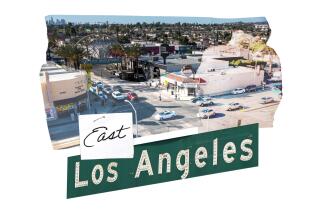Harbor Area Bid to Secede Faces Revenue Concerns
Efforts to save the harbor area’s faltering secession bid went down to the wire Thursday as officials for a state commission struggled to draft a budget that would allow the proposed city to survive apart from Los Angeles.
The cityhood application for San Pedro and Wilmington will rise or fall on a financial viability report expected to be released today by the Local Agency Formation Commission.
“We’re looking under bedcovers; we’re looking behind the chairs” for revenue that would sustain a harbor area city, said Larry Calemine, the commission’s executive director. By law, a secession election cannot be held if LAFCO determines that the breakaway region would not be fiscally healthy.
“I’m hearing that it’s very close,” said Andrew Mardesich, co-chairof the harbor secession campaign. “If things don’t work out, I’m not overjoyed, but I did the best I could to help the community.”
The harbor area is one of three Los Angeles regions--the others are the San Fernando Valley and Hollywood -- whose residents signed petitions authorizing the commission to consider holding secession elections. LAFCO will decide during the next several weeks whether to place the proposals on the November ballot.
The fate of the harbor application is important to the Valley and Hollywood drives, because each secession measure would require the approval of a majority of voters--both within the breakaway area and citywide. Secessionists believe that a simultaneous vote on all three areas would make it more likely that each would win.
But the harbor and Hollywood proposals have been dealt blows recently. State Controller Kathleen Connell has said that her office found that neither area would survive financially as a new city.
LAFCO is not bound by the controller’s findings. The commission’s initial review determined that Hollywood, with its significant retail and commercial sector, would be in good fiscal shape with careful budgeting. Calemine said he will review the controller’s concerns about Hollywood and make recommendations next month.
The harbor proposal remains “problematic,” Calemine said.
A LAFCO analysis earlier this year concluded that the harbor area would have difficulty balancing its budget as an independent city. But it also said the area could be viable if some city services were cut or taxes raised.
Since then, the State Lands Commission has weighed in, saying that it would not allow a harbor city to include the Port of Los Angeles within its boundaries.
That weakened the region’s prospects of making ends meet, Calemine said, because it removed rich sources of tax revenue.
Secessionists submitted a new budget last week that they said reduced the proposed city’s expenses enough to keep it afloat.
Instead of contracting with Los Angeles for key services, as the commission’s consultants had suggested, the harbor could save millions by turning to Los Angeles County for police and fire protection, cityhood proponents said.
Calemine was intrigued by the revised figures, and delayed the release of his report so he could evaluate them. But by late Thursday, it was still not clear that the numbers would pencil out.
“We’re wrestling with trying to find ways that it could be made viable,” Calemine said. He noted that LAFCO is required to try to make cityhood proposals work and get them on the ballot.
Sounding tired, the usually indefatigable Mardesich said L.A. officials have put more effort into defeating secession than addressing the concerns that spurred the harbor movement in the first place.
“The people who say they represent us ... haven’t listened,” he said.
Julie Wong, spokeswoman for Mayor James K. Hahn, said that isn’t true: “The mayor lives in San Pedro and understands the concerns of the people who live there.”
More to Read
Sign up for Essential California
The most important California stories and recommendations in your inbox every morning.
You may occasionally receive promotional content from the Los Angeles Times.










